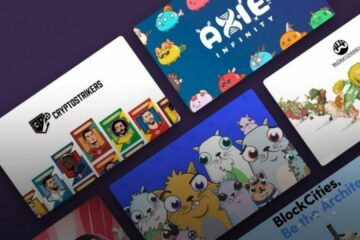Some of the works backed by these “non-fungible tokens” sell for several million dollars, startups that exploit NFTs are on the rise … Are investors right to be so enthusiastic?
The “NFT bros”, these Internet users who, inspired by the “crypto-bros”, swear by the NFTs, are at war. A fierce, fierce battle, the rules of which do not prohibit blows under the belt, against their ultimate nemesis: the “right-click savers”. Yes, yes: those who save images with a simple right click of their mouse.
If you are still unaware of NFTs, this is an advancement in distributed ledger technology that represents a unique feature. This object can be digital or physical, such as a painting, a simple ticket, real estate, a game object, a digital work of art, etc.
Since NFTs are connected to a blockchain network, buyers can trace the origin of the collector’s item and prove its authenticity. On the other hand, artists can prove ownership of their artwork.
Without going into technical concepts, let’s try to understand the use case of NFTs, which might help us understand their purpose and, most importantly, their value.
A unique object – The common theme of NFTs
As everyone – from cartoonists to musicians – uses non-fungible tokens, it becomes difficult to understand their true use case. To be clear, NFTs represent something unique.
It could be a plane ticket, celebrity signature, digital painting, in-game items, Monalisa, your time, or anything of value that someone is ready to buy for a specific price. All a user needs to do is connect the artwork / article to a blockchain network that supports NFT standards, for example, Ethereum, Binance Smart Chain, and Polygon.
For beginners or people who are not tech-savvy, marketplaces like OpenSea, BakerySwap, and Rarible exist that allow them to tie their works to a blockchain. After onboarding, users can auction their items or sell them directly.
Superare offers a way to sell directly, while Auctionity allows artists to auction their work / item. Now that we know that NFTs are indistinguishable and unique, let’s take a look at their use cases.
NFT for digital artists and creators
Blockchain technology has become a great prospect for digital creators as it allows them to symbolize a digital painting, blog post, song, rap, logo, or any other valuable digital piece in the form of an NFT. Creators usually don’t get anything in return for their work. However, with the advent of NFTs, artists can prove ownership of their artwork and make money for it.
Market – Nifty Gateway
The growing interest in NFTs has brought several markets that digital creators can use to sell their work. The most popular is Nifty Gateway, a mix of blockchain technology and collectible artwork. The platform rose to prominence in the NFT industry after Beeple, a digital artist, sold his digital collage for more than $ 69 million.
Owned by the famous Winklevoss brothers, Nifty allows artists to upload their works to Nifty Gateway Omnibus Wallet using the MetaMask wallet. Once uploaded, buyers can place their bid to purchase an underlying item. The platform charges a fee of 5% on the sale plus 30 cents to cover transaction costs.
Luxury and art of living
NFTs no longer just have a digital connotation, they are also a unique piece of luxury lifestyle product. Not just any real world good, but limited edition luxury items, a watch, a purse, beauty accessories, a wallet, to name a few. The non-fungibility of these assets makes them exclusive and unique. Instead of putting a price on a luxury item, market demand sets the value of its DTV. The luxury industry also uses the same logic of rarity to add value to an item. Moreover, with NFTs, companies or creators no longer have to worry about copying luxury goods as users will still be able to verify their authenticity and ownership.
Market – Bling
Launched by Trace Network on Polygon, Bling is the world’s leading NFT marketplace for limited edition luxury and lifestyle products. The platform allows users to connect their wallets to purchase listed NFTs. After purchasing an NFT, buyers can claim the associated physical item. The manufacturer will then send it to the customer, regardless of the location. Since Bling Network uses Polygon to create NFTs, items listed on the platform can be traced back to their respective companies.
Collectibles
Cryptokitties started the collectible mania in 2017. However, the bear market of 2018 and 2019 has slowed their pace. NFTs represent a unique case for collectibles because they allow users to verify the ownership and uniqueness of an item. A collectible card, music video, or picture – all of these things feature NFT collectibles. This new dimension of investment raw materials has opened the floodgates for several platforms. For example, NBA Top Shot has previously sold basketball clips worth $ 100 million. With NFTs in mind, baseball card maker Topps is also planning to enter space.
Marketplace – eBay
ebay, a renowned ecommerce marketplace, has recently entered the blockchain arena by allowing users to trade NFTs. The company has invested heavily in infrastructure for collectibles such as collectible cards and other items, which users can check before purchasing. Since eBay started less than two weeks ago, it has only launched the NFT Marketplace for a small group of verified sellers.
Last word
As you probably know by now, the use cases for NFTs are only limited by our imagination. Undoubtedly, NFTs have great potential to play a vital role in creating an ideal economy for artists and collectors.
Although the concept is old, the past few months have been a wild race for designers and collectors. While the collectibles market has brought in large sums of money to the blockchain industry, it is primarily driven by speculation. The market has more speculators than collectors. Therefore, only time will tell if the craze continues or slows down in the near future.



0 Comments